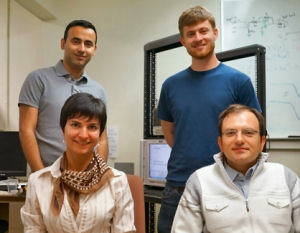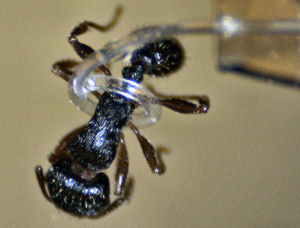
In what its UC Santa Barbara developers say is a significant step toward brain-like computing; a memristor-based circuit of about 100 artificial synapses has performed a typical human task: image classification.
In the researchers’ demonstration, the circuit implementing the rudimentary artificial neural network was able to successfully classify three letters (“z”, “v” and “n”) by their images, each letter stylized in different ways or saturated with noise. In a process similar to how humans pick our friends out from a crowd, or find the right key from a ring of similar keys, the simple neural circuitry was able to correctly classify the simple images.
“While the circuit was very small compared to practical networks, it is big enough to prove the concept of practicality,” said co-developer Farnood Merrikh-Bayat (pictured, top left). Key to the technology is the memristor (a combination of memory and resistor), an electronic component whose resistance changes depending on the direction of the flow of the electrical charge. Unlike conventional transistors, which rely on the drift and diffusion of electrons and their holes through semiconducting material, memristor operation is based on ionic movement, similar to the way human neural cells generate electrical signals.
“The memory state is stored as a specific concentration profile of defects that can be moved back and forth within the memristor,” explained team member Dmitri Strukov, a professor of electrical and computer engineering at UC Santa Barbara (pictured, bottom right). “The ionic memory mechanism brings several advantages over purely electron-based memories, which makes it very attractive for artificial neural network implementation. For example, many different configurations of ionic profiles result in a continuum of memory states and hence analog memory functionality. Ions are also much heavier than electrons and do not tunnel easily, which permits aggressive scaling of memristors without sacrificing analog properties.”
In order to create the same human brain-type analog functionality with conventional digital technology, the resulting device would have to be enormous – loaded with multitudes of transistors that would require far more energy. Memristor-based technology – inspired by biological brain – relies on a completely different way to carry on computation.
To be able to approach functionality of the human brain, however, many more memristors would be required to build more complex neural networks to do the same kinds of things we can do with barely any effort and energy, such as identify different versions of the same thing or infer the presence or identity of an object not based on the object itself but on other things in a scene.
“The exciting thing is that, unlike more exotic solutions, it is not difficult to imagine this technology integrated into common processing units and giving a serious boost to future computers,” said team member Mirko Prezioso.
The researchers now plan to improve the performance of the memristors, scaling the complexity of circuits and enriching the functionality of the artificial neural network. The next step is to integrate a memristor neural network with conventional semiconductor technology, which will enable more complex demonstrations and allow this early artificial brain to do more complicated and nuanced things.
Related:
Discuss this article in our forum
Demonstration of memflector brings brain-like computing a step closer
International team claim organic computing breakthrough
“Super-Turing” AI gets development funding
Mushy memory brings biocompatible electronics a step closer








Comments are closed.